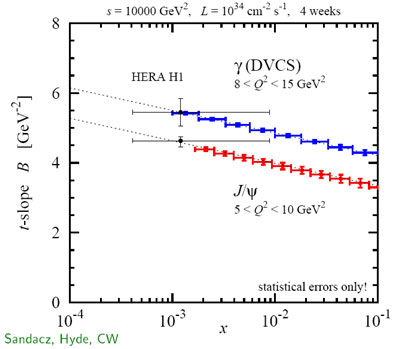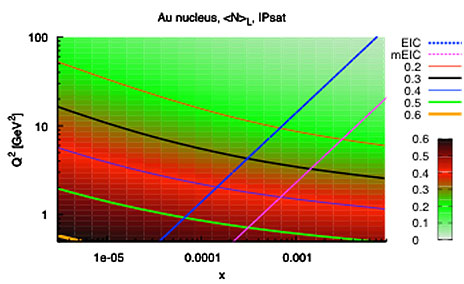
INSTITUTE FOR NUCLEAR THEORY
News
Home | Contact | Search | News archive | Site Map

|
INSTITUTE FOR NUCLEAR THEORY News
Home | Contact | Search | News archive | Site Map |
|||||
Gluons and the Quark Sea: Distributions, polarization, tomography
The INT program on Gluons and the Quark Sea addressed outstanding open questions in our understanding of the partonic sub-structure of hadrons and nuclei at high energies. Despite much progress, basic questions of fundamental interest are either unresolved or have a significant degree of ambiguity in their interpretation. These include
In addressing these major open conceptual issues regarding the fundamental structure of matter, a significant focus of the program was to formulate these questions in a concrete fashion such that the answers to these questions would help articulate a strong scientific case for a future high energy, high luminosity Electron-Ion Collider (EIC). Specifically, a goal of the program was to achieve convergence of different groups on golden measurements unique to an EIC that would make clear the importance of such a collider to a wider scientific community.
The first week of the program was a general workshop on perturbative and non-perturbative aspects of QCD at Collider energies bringing together experts in these areas. There were experimental reviews of the physics achievements at HERA and the fixed target DIS programs, discussions of ongoing research and future plans at RHIC and Jlab, and exciting recent results from the LHC. On the theory side, talks addressed the status of perturbative techniques such as small x and soft gluon resummations, soft collinear effective theory and QCD factorization. There were also interesting talks on collider signatures of fundamental non-perturbative effects such as chiral symmetry breaking and the scale anomaly. Techniques discussed included Schwinger-Dyson truncation methods, quark models and lattice computations. An interesting benchmark for our understanding of the interplay of perturbative and non-perturbative effects in QCD is heavy quarkonium and there were talks on its production and scattering in QCD media. Two major topics of interest for a future EIC are the structure of hadronic matter at small x and spatial imaging of the partonic structure of the hadron. On the former topic, there were several talks on parton saturation and the Color Glass Condensate (CGG) while the latter discussed Generalized Parton Distributions (GPDs) and Transverse Momentum Distributions (TMDs). Finally, there were EIC specific talks on accelerator and detector studies of an EIC and a discussion of possible time lines for realization of the project. The rest of the program was organized along the following major themes:
The Conveners' tasks were to co-ordinate the presentations on these topics, guide discussions on measurements with the goal of isolating "golden" measurements.
The outstanding puzzle of how the proton spin is constituted was discussed in week 2 and in part in weeks 6-9. The measurement of the polarized structure function
g1 and especially its change with Q2 is viewed as one of the important measurements
at an EIC. It would definitively pin down the contribution of the gluons to the proton spin. Semi-inclusive measurements would allow access to the polarized antiquark distributions, which currently are not well constrained. The contradictory results regarding the strange sea especially require clarification, not only through low energy measurements, but over a wide range of x and Q2 as well.
The generalized parton distributions describing proton helicity flip (commonly denoted by Eq and Eg) are of particular interest since they contain information about the orbital angular momentum carried by quarks or gluons. They are experimentally accessible in DVCS and vector meson production on a transversely polarized target. An EIC will offer the possibility of studying these distributions which, for sea quarks and gluons, are completely unknown at present and only weakly constrained in size by general principles. A realistic and quantitative assessment of the prospect of evaluating Ji's angular momentum sum rule from Eq and Eg as measured in exclusive processes is difficult and will require further detailed studies beyond those available at the program.
Apart from the collinear polarized quark and gluon distributions, the field of the transverse momentum dependent distributions (TMDs) could really benefit from studies
at an EIC. The Q2 evolution of TMD asymmetries such as the Sivers asymmetry has not been studied experimentally. From the theory side much work needs to be done. For instance, the role of gluon TMDs could be studied rather cleanly for the first time at EIC. During the INT program much progress on the theory side was made and many new results on TMD asymmetry studies are in preparation as a result of the program.
QCD matter in extreme environments was discussed at length in weeks 3-5. Significant uncertainties persist with the nuclear parton distributions throughout the x, Q2 plane. Besides intrinsic interest, parton distributions are an important input into the computation of observables in heavy ion collisions and in electroweak processes. Particularly noteworthy is the fact that the nuclear gluon distribution is completely unknown for x < 10-2. The EIC will measure for the first time the longitudinal nuclear structure function FLA, which at small x is sensitive to the nuclear gluon distribution. Model independent extraction of quark singlet and gluon distributions at small x is allowed by independent measurements of the structure functions F2 and FL. This measurement is therefore considered a strong candidate for a golden measurement. Another golden measurement is semi-inclusive measurements of di-hadrons that probe small x in nuclei; predictions in the CGC suggest that these are strongly decorrelated in azimuthal angle with decreasing x and increasing nuclear size. While such a phenomenon has been seen in deuteron-gold collisions, spectator interactions obscure the theoretical interpretation. A third key measurement is coherent and incoherent diffractive and exclusive measurements with striking effects predicted at high parton densities. An intriguing possibility discussed is to extract information on the partonic nature of short-range nuclear forces by measuring exclusive photo-production of J/ψ's.
How colored probes interact with QCD matter addresses fascinating questions regarding the nature of multiple scattering, color coherence, energy loss and the nature of in-medium hadronization. These studies of "cold" QCD matter in e+A collisions complement those of hot QCD matter in heavy ion collisions. Studies show that with its unprecedented x-Q2 coverage and collider kinematics, the EIC could vastly extend the range of previous studies. Because charm and bottom mesons will be accessible, the EIC can study for the first time with high precision the energy loss of heavy quarks in cold nuclear matter. One has likewise the possibility of the first study of the medium modification of jets in nuclei.
The prospects of performing a detailed spatial imaging of quarks and gluons
in the nucleon through exclusive reactions was discussed in weeks 8 and 9.
Potential golden measurements that were identified in this area are deeply virtual Compton scattering and vector meson production; these contain a large number of observables that can be interpreted in terms of generalized parton distributions. Among the vector meson channels, J/Psi production plays a unique role due to its selective sensitivity to gluons in the proton. With the cross sections and luminosities anticipated at an EIC both vector meson production and DVCS could be measured differentially in several variables and in a wide kinematic range, allowing in particular the use of their Q2 dependence as a detailed probe of the underlying dynamics. With the detection of the scattered proton in Roman pots and, at larger momentum transfers, in the main detectors, current estimates suggest that from the point of view of acceptance and statistics one may be able to determine the spatial distribution of sea quarks and gluons at distances between 0.1 fm up to 2 fm or more from the proton center. The extent to which these numbers are influenced by the limitations of the experimental resolution remains to be determined.
Opportunities for electroweak physics at an EIC were discussed in week 7. Three major avenues were identified in this area. Measurements of the nucleon's parity-violating spin structure functions would be a highlight at the EIC, as they would provide new information on helicity parton distributions, complementary to deep-inelastic scattering through photon exchange. Estimates show that the electroweak structure functions should definitely be accessible at the EIC. The charged-current sector in particular shows
large spin asymmetries and appears very promising. A second focus was the question if the EIC would allow measurements of parameters of the electroweak theory. Here
the studies suggest that for high energy and luminosity there are promising prospects for extractions of the weak mixing angle, which should even be possible over a fairly wide range in Q2 so that its running can be established. Finally, the question was addressed if the EIC might be able to open a window on new physics beyond the standard model, assuming that conditions are favorable. Here, most attention was paid to possible electron-tau conversion as a direct signal for new physics. Both the theoretical status and the experimental aspects of e-tau conversion were discussed. Current estimates suggest that this channel would be very challenging at the EIC, in particular concerning detector responses and efficiencies. As measurements of electroweak parameters appear generally possible at the EIC, further studies will address whether the precision of such measurements would be high enough to detect small deviations from the standard model predictions. A full study of a "global survey" of electroweak parameters from EIC data -- much in the spirit of the approach also taken at HERA -- is still outstanding but planned.
The program concluded with a workshop on "The science case for an EIC". In addition to review talks on the status and outstanding remaining questions in the thematic areas identified, there were talks by the respective conveners summarizing the discussions in the focus weeks with a view to isolating golden measurements that will be both unique to an EIC and offering the greatest promise for fundamental progress in the strong interactions. The consensus was that great progress has been made in this direction. The main conclusions and the supporting studies will be compiled in a joint BNL/INT/Jlab document on the science case of the EIC.
(INT Program September 13 to November 19, 2010)
Reported by Daniel Boer (Groningen), Markus Diehl (DESY), Richard Milner (MIT),
Raju Venugopalan (BNL), Werner Vogelsang (Tübingen)
Date posted May 18, 2011
![]()

for two different distributions of initial nucleon configurations.

from deeply virtual Compton scattering (DVCS) and exclusive J/ψ production at an EIC.

distribution available from a measurement of the g1 structure function at EIC
